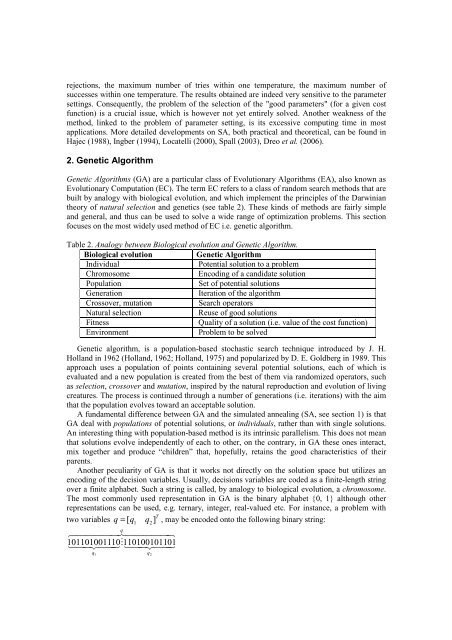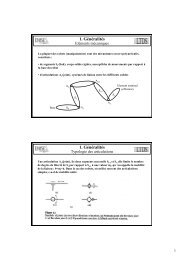q - Rosario Toscano - Free
q - Rosario Toscano - Free
q - Rosario Toscano - Free
Create successful ePaper yourself
Turn your PDF publications into a flip-book with our unique Google optimized e-Paper software.
ejections, the maximum number of tries within one temperature, the maximum number of<br />
successes within one temperature. The results obtained are indeed very sensitive to the parameter<br />
settings. Consequently, the problem of the selection of the "good parameters" (for a given cost<br />
function) is a crucial issue, which is however not yet entirely solved. Another weakness of the<br />
method, linked to the problem of parameter setting, is its excessive computing time in most<br />
applications. More detailed developments on SA, both practical and theoretical, can be found in<br />
Hajec (1988), Ingber (1994), Locatelli (2000), Spall (2003), Dreo et al. (2006).<br />
2. Genetic Algorithm<br />
Genetic Algorithms (GA) are a particular class of Evolutionary Algorithms (EA), also known as<br />
Evolutionary Computation (EC). The term EC refers to a class of random search methods that are<br />
built by analogy with biological evolution, and which implement the principles of the Darwinian<br />
theory of natural selection and genetics (see table 2). These kinds of methods are fairly simple<br />
and general, and thus can be used to solve a wide range of optimization problems. This section<br />
focuses on the most widely used method of EC i.e. genetic algorithm.<br />
Table 2. Analogy between Biological evolution and Genetic Algorithm.<br />
Biological evolution Genetic Algorithm<br />
Individual Potential solution to a problem<br />
Chromosome Encoding of a candidate solution<br />
Population Set of potential solutions<br />
Generation Iteration of the algorithm<br />
Crossover, mutation Search operators<br />
Natural selection Reuse of good solutions<br />
Fitness Quality of a solution (i.e. value of the cost function)<br />
Environment Problem to be solved<br />
Genetic algorithm, is a population-based stochastic search technique introduced by J. H.<br />
Holland in 1962 (Holland, 1962; Holland, 1975) and popularized by D. E. Goldberg in 1989. This<br />
approach uses a population of points containing several potential solutions, each of which is<br />
evaluated and a new population is created from the best of them via randomized operators, such<br />
as selection, crossover and mutation, inspired by the natural reproduction and evolution of living<br />
creatures. The process is continued through a number of generations (i.e. iterations) with the aim<br />
that the population evolves toward an acceptable solution.<br />
A fundamental difference between GA and the simulated annealing (SA, see section 1) is that<br />
GA deal with populations of potential solutions, or individuals, rather than with single solutions.<br />
An interesting thing with population-based method is its intrinsic parallelism. This does not mean<br />
that solutions evolve independently of each to other, on the contrary, in GA these ones interact,<br />
mix together and produce “children” that, hopefully, retains the good characteristics of their<br />
parents.<br />
Another peculiarity of GA is that it works not directly on the solution space but utilizes an<br />
encoding of the decision variables. Usually, decisions variables are coded as a finite-length string<br />
over a finite alphabet. Such a string is called, by analogy to biological evolution, a chromosome.<br />
The most commonly used representation in GA is the binary alphabet {0, 1} although other<br />
representations can be used, e.g. ternary, integer, real-valued etc. For instance, a problem with<br />
T<br />
two variables q = q q ] , may be encoded onto the following binary string:<br />
[ 1 2<br />
q<br />
6444447<br />
444448 1011010011<br />
14<br />
4 2443<br />
10M1101001011<br />
14<br />
4 2443<br />
01<br />
q1 q2



